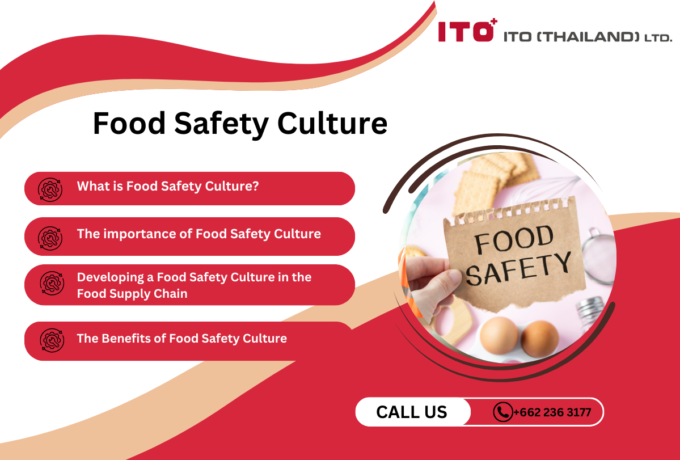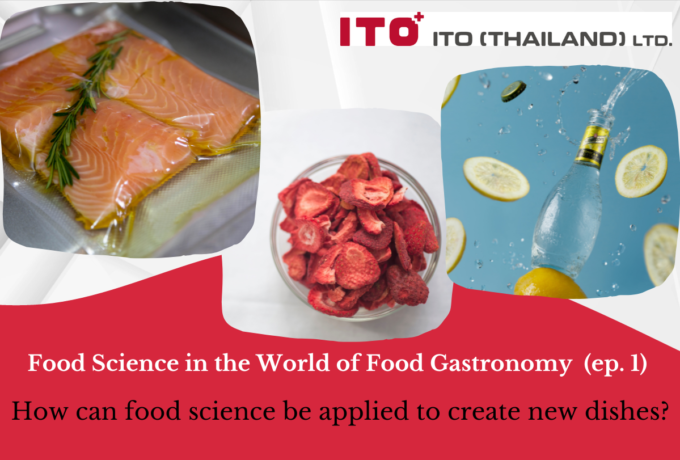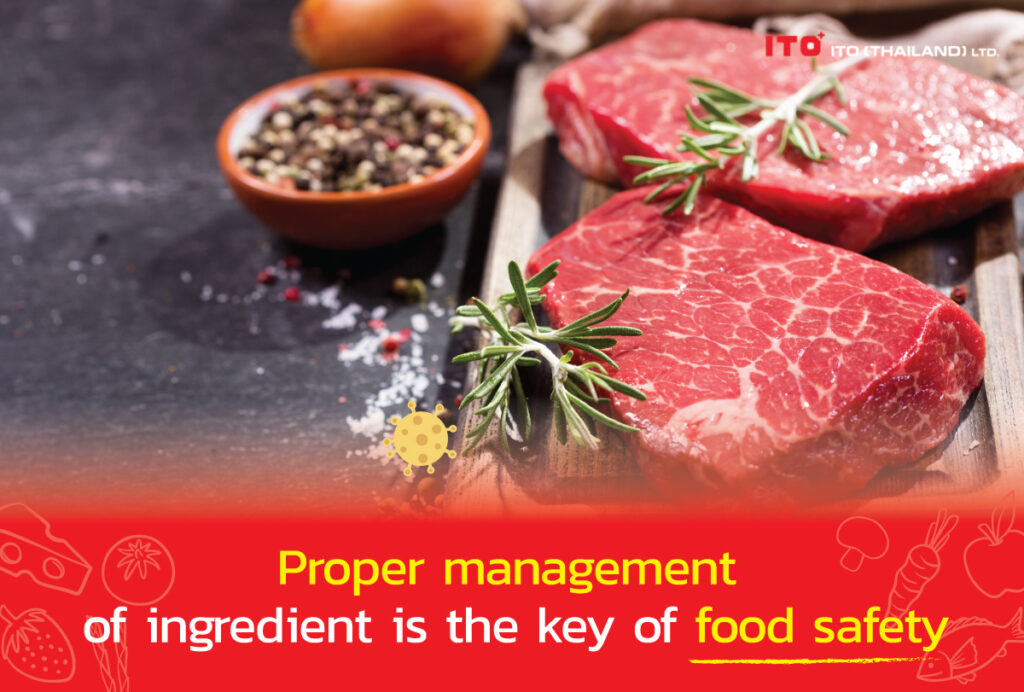ITO Thailand Hygiene Blog
Raw Material Management (Meat products)
In this article, we are going to find out what is the best selection of raw materials, how to properly manage raw materials according to food safety, and what is the principle of food quality.
In general, various processed food products start with raw materials such as meat, after which it will be sent to the factory for processing into the desired characteristics, sent to the warehouse to wait for transportation, and finally it will be sent to various retail channels such as supermarkets and so on. During the transportation and food processing, there is a risk of contamination from physical, chemical and biological hazards, including cross contamination if raw materials are not properly handled.
The first important thing is classification of raw materials to suit the management. In this article, we will talk about meat management as a guideline for basic practice as follows:
Usually after killing and slaughtering, meat will not have oxygen flowing to the muscles resulting in an anaerobic cellular respiration reaction, and an accumulation of lactic acid, which will decrease pH level causing the condition of contraction of the muscles (Rigor mortis). Thus, in order to trim these carcasses, it is necessary to leave them through the Rigor mortis phase to make the meat less tough. This varies depending on the type of animals, for example 18-24 hours and 5 hours for beef and pork, respectively. (1)
Animal stress, including the conditions of animal handling before slaughter, is known to directly affect the quality of the meat. The condition of the meat that we do not want first is “Dark, Firm and Dry; DFD.” This type of meat has dark color, reddish-purple color and can be dark to almost black, and has a hard surface because protein has a very high water holding capacity. Glycogen is a precursor for the formation of lactic acid. Stress can stimulate the use of more glycogen, which is common in muscles. When more glycogen is used, there are not enough precursors to form lactic acid. When the amount of lactic acid is less, pH of the meat will drop to 5.9-6.5, which is higher than the expected value of 5.7, resulting in DFD(2) , which is most often found in beef, goat, and mutton.
The cause is usually due to non-standard transportation, raising animals in confined spaces, crowding, temperatures that are too hot or too cold, the animal is not getting the right amount of food, or even raising with other animals and so on. These can cause the animal to accumulate stress for a long time before slaughter.
The opposite condition is “Pale, Soft and Exudative; PSE” in which the meat becomes pale due to the loss of myoglobin and becomes wet because the protein loses its ability to hold water caused by high lactic acid in the muscles (as a result, the meat has low pH). The pH decreases dramatically due to the stress that the animal has for a short time before slaughtering. It is also sticky when cooked. PSE is more common in pork and chicken, but some studies have reported that it occurs in beef as well. (3)
Meat is a source of protein. It is also rich in vitamins and minerals such as iodine, iron, zinc, vitamin B12 and omega 3, which are essential for the body. Consumers should buy meat that is in complete packaging, has a production date or expiration date clearly stated, and is stored in a refrigerator at a temperature below 4°C to reduce the growth of pathogenic microorganisms. They also should cook food at different safe temperatures for different types of meat, such as fish at 63°C, minced meat or sausages at 71°C, and beef at 63, 70, 77°C for medium rare, medium, well done respectively. (4) The reason why we can consume raw beef (for example, at the rare level) is because beef has a dense texture, and pathogenic microorganisms tend to be on the surface of the beef so they cannot penetrate inside unlike other types of meat such as chicken and pork that cannot be consumed raw. In addition to the type of meat, it also depends on other factors such as the source of raw materials, correct management of raw materials, compliance with sanitary principles and so on. (5)
However, the quality and nutritional value of fruits and vegetables or other raw materials like meat can decrease due to many factors, such as improper temperature storage or bruises from bumps caused by transportation and insects because these bruises are a channel for bacteria to spoil vegetables and fruits and cause them to have a shorter lifespan which we will talk about next time.
ITO THAILAND would like to stay beside the consumers by taking part in developing and improving the production process together with food manufacturers to be standardized, hygienic, legitimate with food law and take the best interests of consumers into account by offering services to manage hygiene measures according to the work site of each food factory, raising awareness about hygiene, providing hygiene management and consultation with on-site workers and also providing comprehensive after-sales service. Please click here to know more about us.
References
1.Kanithaporn Vangnai. Meat and poultry products technology. [Handout] Department of Food Science and Technology, Kasetsart University.
2.Courtney Simons. DFD AND PSE MEATS [Internet]. [cited 23 Feb 2022]. Available from https://cwsimons.com/meat-quality-dfd-and-pse-meats/
3.Aalhus, J.L.; Best, D.R.; Murray, A.C.; Jones, S.D.M. A comparison of the quality characteristics of pale, soft and exudative beef and pork. J. Muscle Foods 1998, 9, 267–280
4.Better Health Channel. Meat and poultry [Internet]. 2017 [cited 23 Feb 2022]. Available from https://www.betterhealth.vic.gov.au/health/healthyliving/Meat-and-poultry
5.John Staughton. Why Are Some Meats Eaten Raw And Some Are Not? [Internet]. 2022 [cited 23 Feb 2022]. Available from https://www.scienceabc.com/humans/why-are-some-meats-eaten-raw-and-some-are-not.html
Related Post
-

Food Safety Culture
Food safety culture plays a crucial role in safeguarding the company's reputation, ensuring the well-being of its employees, and providing a safe experience for its customers.
-

New food source safety issues
What are safety issues worth knowing for trendy new food sources like plant-based and insect-based proteins?
-

British Retail Consortium (BRC) Standard
Food safety management systems play a vital role in ensuring the production and distribution of safe and high-quality food products to consumers. With the global food supply chain becoming increasingly complex, food businesses must implement effective systems prioritising safety, quality, and compliance with industry standards. A food safety management system encompasses a set of procedures, processes, and controls designed to identify, prevent, and manage potential hazards at every stage of the food production and supply process. This proactive approach not only safeguards consumers' health but also protects the reputation and credibility of food companies in an ever more competitive market.
-

Food Science in the World of Food Gastronomy (Part 1)
How can food science be applied to create new dishes?
-

FSSC 22000
Food manufacturers must ensure food safety standards and processes. FSSC 22000 is an official certification program for Food Safety Management Systems (FSMS) recognised by the Global Food Safety Initiative (GFSI). This certification scheme offers a set of guidelines and procedures to ensure uniformity, openness, and safety across your entire supply chain. It applies to all companies operating within the food and beverage industry, ranging from farmers to retailers. By fulfilling the necessary criteria and obtaining FSSC 22000 certification, it is demonstrated that the required standards for food quality and implementing effective processes to manage and mitigate risks associated with food fraud, foodborne illnesses, expensive recalls, and other external threats are met.
-

Food Safety Aspects of Artificial Sweeteners
Artificial sweeteners, also known as sugar substitutes, non-nutritive sweeteners, or high-intensity sweeteners, are artificially produced compounds utilised in place of sucrose (table sugar) to add sweetness to food and drinks. Due to their significantly higher sweetness than regular sugar, only a fraction of artificial sweeteners (200 to 20,000 times less) is required to achieve an equivalent level of sweetness. Since the caloric contribution of these sweeteners, when used in such small quantities, is insignificant, they are often referred to as non-nutritive (4).










